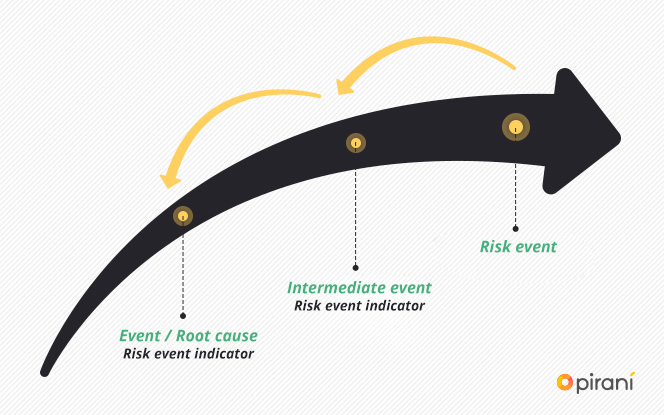Everything you need to know about Key Risk Indicators (KRIs)
Introduction
As a risk manager, you may have heard about risk indicators. But if you have gotten this far, you may be wondering how to use them to further your company's goals. Well, here we will explain everything you need to know about risk indicators, their importance and their main characteristics.
|
Table of Contents |
What are key risk indicators?
There are different types of indicators: Key Control Indicators (KCIs), Key Risk Indicators (KRIs) and Key Performance or Volume Indicators (KPIs).
A risk indicator is an essential tool used to monitor and mitigate the impacts of potential threats.
Unlike KPIs, which measure how well a process has performed in the past, or KCIs, which measure the effectiveness of a particular control, KRIs, or risk indicators, are an essential metric to measure the likelihood of a future impact.
The word "key" indicates that this indicator stands out above any other. Therefore, if there are many KRIs, it is likely that they are only risk parameters.
In this sense, KRIs are used not only to detect potential threats and control their impact. They are also used to allocate time and resources optimally. In other words, they show how efficient an organization is in meeting its objectives.
Why use them?
If a company measures everything, it is not really measuring anything. Therefore, key risk indicators are fundamental in any management process, because they provide relevant information that serves to make timely decisions and focus on the most urgent risks.
Among the main reasons for using risk indicators, their dynamism and usefulness in benchmarking processes stand out. In addition, indicators help identify risk trends before they occur. They also validate and improve the risk assessment framework.
Furthermore, they can facilitate budget planning and help organize an organization's priorities according to the changes it goes through.
Finally, risk indicators are necessary in any project because they strengthen the risk culture within the organization. KRIs can be a means of communicating the urgent nature of some risks and increasing team members' knowledge of safety and risk mitigation mechanisms.

What characteristics should they have?
A good key risk indicator must have 3 essential characteristics to meet their objective: be measurable, quantifiable and accurate.
This means, first of all, that it must be quantified as an amount or percentage, or it must have values that show evolution over time.
Secondly, they should be easy for the team to understand. Each member working on the project should be familiar with them so as to reduce the possibility of misinterpretation.
Finally, an indicator must also be effective or accurate. This means that it must be applicable to specific risks or to controls that are deficient.
Choosing many KRIs can make it difficult to collect, analyze and process the data. That is why they must be chosen carefully.
How to design them
One tactic for developing a KRI is to identify a risk that has been identified in the past or is currently being identified. After that, look back to find out what triggered it and when it occurred. The closer you are to the ultimate cause of the risk, the easier it will be to make the relevant decisions.

In this framework, we can see that it starts at a root cause. Then you come to an intermediate event, which can serve as a key risk indicator. All this works as a chain of events, which aims to get to the beginning.
This analysis can be used by you as a risk manager in order to monitor and propose mitigation tactics. This is the first step to reducing the impacts of a risk, even before it occurs.
Steps for designing a key risk indicator
- Identify the KRIs: list existing metrics and classify them according to historical performance and predictability. You probably have a lot fewer from the second category. After doing this, determine where the voids are according to those metrics.
- Select them: choose the KRIs that meet the above conditions, i.e. measurable, comparable and effective. Make sure that the ones you choose help to identify the root cause of the events.
- Determine what the triggers are: establish what kind of actions can trigger a threat and create an action plan to deal with it.
- Monitor them: after you have made the list of KRIs, you should continue to monitor and assess your performance.

Where to find information to develop them
There are many sources from which KRIs can be extracted. On the one hand, there are external data, such as customer or industry financial reports, as well as economic indicators.
On the other, there are internal data, such as price trends, labor issues, company capacity, among other KRIs that provide important data to anticipate potentially damaging events.
The alignment of the people involved is very important to developing more effective KRIs. Hence the basic need to have a single criterion regarding the definition of the individual data to be collected.
While it may be easier to obtain internal sources of information, the most significant ones usually come from external sources. These sources can help with the identification of potential risks that the company is not yet
aware of.

